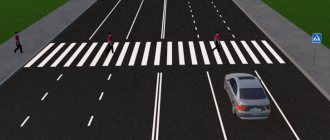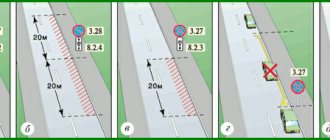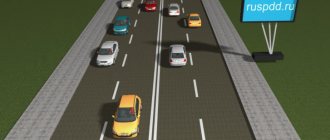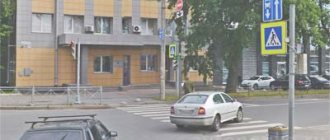roadway
Road Elements
The emphasis in this term is on trackless vehicles.
Tram tracks are not roadways.
- In special cases, the movement of trackless vehicles is allowed on tram tracks, but they are not intended for these purposes. Tram tracks are not located "on the" roadway, and "on the left of" - in cases where movement on them is allowed.
Rails to the left of the roadway"
An alternative understanding of the intersection of roadways
At the end of this article, I propose to consider an alternative understanding of the concept of “crossing roadways”:
Notice the pink corners. They are designed for vehicle movement, i.e. they are either independent roadways or belong to the roadways of one of the intersecting roads (the concept of “roadway” is given above).
With this approach, it turns out that the boundaries of the intersection coincide with the boundaries of the intersection of roadways. And this leads to drivers complying with the requirements of the above paragraphs of the rules differently.
Let me emphasize once again that this point of view is an alternative one. There is no need to rely on it when passing driving exams or disputes with traffic police officers.
Road lane
From the definitions of “road” and “roadway”, “traffic lane” is the third most nested element of the road.
The main element, the road, includes the roadway, and the roadway element is the traffic lane. Based on these terms, the existence of a traffic lane is impossible without a road. For a long time there was a dispute about the presence of roadways in courtyards and other adjacent areas.
This issue was closed by the decision of the Supreme Court of the Russian Federation in case No. AKPI12-205 dated April 17, 2012, with consideration of the contradictions of the Road Traffic Rules of the Russian Federation and the Convention on Road Traffic. In particular, this decision contains that elements of the road network can be located in adjacent areas.
in adjacent territories there may be elements of the road network (roadway, sidewalk, etc.), the totality of which constitutes a road according to the definition of the term “road” in paragraph 1.2 of the Rules
On the one hand, this goes beyond the strict framework of the elements described in the text, on the other hand, it falls within the logical framework. The adjacent territories are also intended for traffic, road accidents occur there and traffic is regulated by the same rules. Regulatory documents on road construction come into conflict, and then the means of organizing traffic. Sometimes it is impossible to visually distinguish a road and the surrounding area without finding out who owns a specific piece of land. In adjacent territories, roads are not built as linear construction projects, but individual elements can form a road in the context of the Road Traffic Regulations. Other departments that deal with traffic on the road network are responsible for organizing traffic in the adjacent territory.
Returning to traffic lanes, it is also often impossible to mark them according to regulatory documents (for example, ensure a width of 3 meters, mark them with appropriate intersection signs, and so on. But again, in the context of traffic rules terms, there are traffic lanes in the adjacent territories.
Purpose of road elements
A road is a part of land (or an artificial structure) intended for vehicle traffic. The road structure includes several elements (roadway and, if possible, dividing strip, sidewalk, shoulder, tram tracks).
A city road is a road built within a populated area; a country road, respectively, is one that is laid outside the populated area. A city road includes the following elements: roadway, sidewalk, tram tracks (optional), dividing strip (optional). A country road includes the following elements: roadway, shoulder, ditch, dividing strip (optional).
Purpose of road elements:
A city road is a road built within a populated area;
a country road, respectively, one that is laid outside the boundaries of a populated area; the roadway is intended for the movement of trackless vehicles; pedestrians are prohibited from moving along the roadway;- the sidewalk (French trottoir from trotter - walk quickly) is intended for pedestrian traffic; vehicles are prohibited from moving on the sidewalk. The sidewalk is built in such a way that it is higher than the level of the roadway;
- tram tracks are intended for the movement of trams, other vehicles are allowed to enter tram tracks in the same direction, located at the same level as the roadway, if the vehicle does not interfere with the movement of the tram;
- the shoulder is intended for stopping and parking vehicles; pedestrians are allowed to move along the roadside, observing safety rules;
- a ditch (French cuvette, lit. - tub, basin) is designed to collect and drain water from the road surface;
- A median strip (not to be confused with a dividing line!) divides the road into oncoming carriageways and is not intended for the movement or stopping of trackless vehicles and pedestrians.
On a two-way road, drivers should only move on the right side of the roadway. Pedestrians on a city road should only move on the right side of the sidewalk at a calm pace.
Marked or unmarked
From the paragraph above, according to regulatory documents, it is possible to designate only lanes on correspondingly “regulatory” roads. Means of organizing traffic in adjacent areas can also be used, but depending on the situations, their requirements may differ. For example, you can often see the 5.5 sign at gas stations and parking lots. “One-way traffic”, but since there is no “standard” road, it will not be possible to move along one-way traffic in violation. In the same parking lot, on the opposite side, there is a “Brick” hanging - it is no longer tied to the road, and a lawful fine will be issued for violating this sign. You can often find narrow lane markings in parking lots, and no one will issue a fine for violating such markings or driving into oncoming traffic for crossing a solid line. Mandatory and priority signs must be followed. And so on, there are many cases.
Determining the number of traffic lanes by markings
Any marking that marks the edge of a lane determines the number of lanes on the road. Solid line, double solid, dashed and so on.
Double continuous marking line 1.3 can be used on two-lane roads with a lane width of more than 3.75 meters
Determining the number of traffic lanes by markings
And of course, the number of lanes can be determined by markings with the simultaneous use of signs. At the same time, we remember that if there is a conflict between road signs and markings, the signs should be followed.
Temporary markings take precedence over permanent markings and signs.
Longitudinal strip
And even in the “longitude” of the strip, disputes arise. There is a longitudinal stripe in the profile of a “normative” road, and there is a longitudinal stripe in the direction of the road.
Longitudinal strip
Here you should look in reverse and imagine a non-longitudinal strip - the option suitable for traffic rules will become obvious.
Profile of a roadway with a longitudinal stripe
Longitudinal strip of the roadway
It quite fits the definition; the strip runs along the surface of the roadway. This looks ridiculous until the physical width of the road changes. When the road narrows, someone allows the traffic lane to be positioned across the roadway.
Road narrows
Lane width
“Having a width sufficient to allow vehicles to move in one row.”
Here the dispute arises from a certain conclusion about the prohibition of two cars in one lane. This conclusion has no basis. The term defines a traffic lane. And if the width is sufficient for the movement of cars in one radius, it is a traffic lane; if it is not enough, it is not a traffic lane. Under different conditions, the number of stripes may change while maintaining the same width. The basis for choosing the number of lanes is maintaining a safe interval between vehicles.
An example of increasing the number of stripes while maintaining the original width in the probok.net project:
Adding a lane by narrowing other lanes
The road and its main elements
The central concept of traffic rules is the road. “Road” is a strip of land or a surface of an artificial structure equipped or adapted and used for the movement of vehicles. The road includes one or more carriageways, as well as tram tracks, sidewalks, shoulders and dividing strips, if any.
Suitability for traffic is one of the main criteria of a road. An embankment, a dam, an asphalted, concreted, paved section of the earth's land, etc., along which vehicles (hereinafter referred to as vehicles) move, is a road. Artificial structures (overpasses, overpasses, bridges) that are used to move vehicles are also roads.
A road is a section prepared and intended for vehicle traffic.
It includes the following main elements:
- roadway: a road element intended for the movement of trackless vehicles;
- traffic lane: any of the longitudinal stripes of the roadway, marked or not marked with markings and having a width sufficient for the movement of cars in one row;
- dividing strip: a road element, distinguished structurally and (or) using markings 1.2.1, separating adjacent roadways and not intended for the movement and stopping of vehicles;
- shoulder: an element of the road adjacent directly to the roadway at the same level with it, differing in the type of surface or marked out using markings 1.2.1 or 1.2.2, used for driving, stopping and parking in accordance with the Rules;
- sidewalk: an element of the road intended for pedestrian traffic and adjacent to the roadway or bicycle path or separated from them by a lawn.
The number of lanes on the roadway for the movement of non-rail vehicles is determined by road markings or road signs 5.16, 5.17.1, 5.17.2, and in their absence - by the drivers themselves, taking into account the width of the roadway in the corresponding direction of travel, the dimensions of vehicles and the safe intervals between them.









